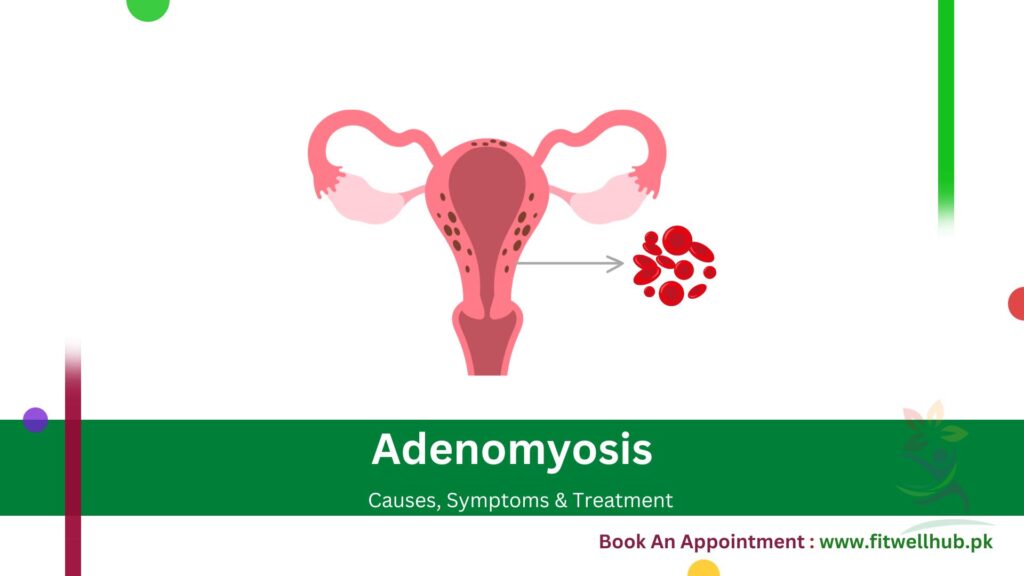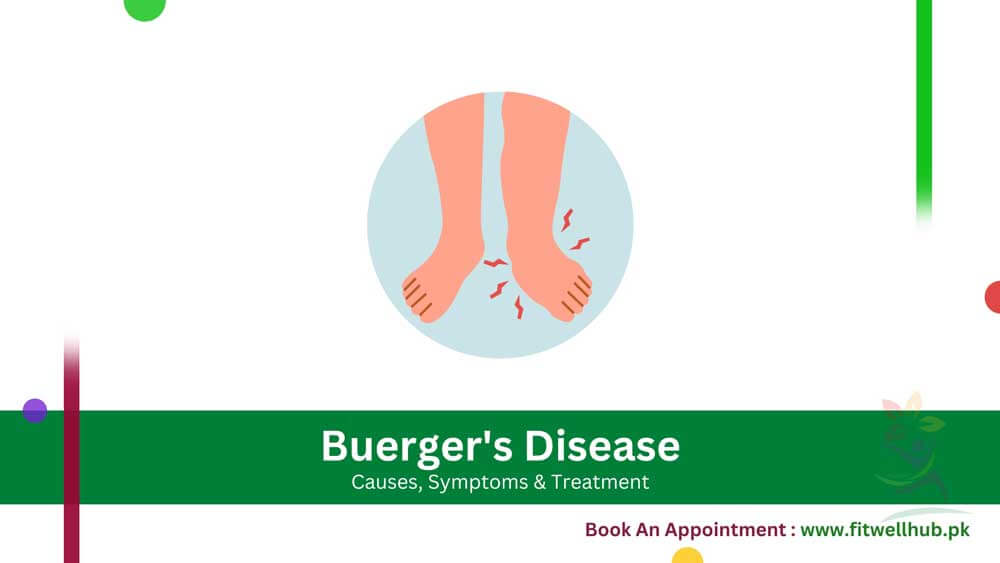In adenomyosis, the uterus is affected by the growth of tissue (normally lining the inside of the uterus) into the uterus’s muscular wall. These displaced tissues act normally throughout each menstrual cycle, thickening, breaking down, and bleeding. This condition can cause symptoms such as heavy bleeding, pelvic pain, and severe menstrual cramps. Although adenomyosis is not life-threatening, it can significantly affect fertility and quality of life. The exact cause of adenomyosis is not fully understood, but possible factors include hormonal imbalances, previous uterine surgery (such as a C-section), inflammation of the uterine lining, and genetic predisposition.
Quick Links
ToggleIt is usually overlooked or misdiagnosed because some of the adenomyosis symptoms resemble gynecological conditions such as fibroids or endometriosis. It is crucial to understand adenomyosis to diagnose and treat it properly. The causes of adenomyosis are still not determined by doctors but its treatment can be possible after menopause. Hormonal treatment approaches are used for curing women going through severe discomfort due to adenomyosis. Adenomyosis treatment can be done by removing the uterus (hysterectomy).
Symptoms
Adenomyosis can be diagnosed through different symptoms and affects women in different ways. Sometimes, adenomyosis shows no symptoms or signs but only a little discomfort. However, some of the major symptoms are given below:
- Heavy menstrual bleeding (menorrhagia), leading to anemia and fatigue
- Severe pelvic pain
- Discomfort in the lower abdomen or back, often mistaken for regular period cramps
- Bloating and feeling fullness in the pelvic region
- Enlarged uterus
- Painful intercourse (dyspareunia)
Some Of these are describe given below:
1- Heavy menstrual bleeding
One of the main symptoms of adenomyosis is heavy bleeding during menstruation commonly known as menorrhagia. When women undergo unusually long and heavy menstrual periods that last for more than 7 days along with cramps then there is a possibility of having adenomyosis.
2- Severe pelvic pain
A chronic pain in the lower abdomen or pelvis of women especially during intercourse or menstruation. It can last longer for almost 6 months, come and go, or be constant. It can lead to social, emotional, and economic problems.
3- Enlarged Uterus
Due to adenomyosis, the uterus may become larger. Even though it might not be realized when someone notices pressure or tenderness below the abdomen, her uterus is larger.
If the symptoms mentioned above occur and affect your life routine adversely then it is important to visit a doctor for complete diagnosis and treatment.
When to See a Doctor
When you are going through heavy menstrual bleeding or constant pelvic pain that affects your life routine adversely then that might be a time to see a doctor. Moreover, suppose you are unable to conceive while trying and have doubt that adenomyosis may be the reason. In that case, it is important to consult a doctor for further diagnosis and treatment.
If you are having symptoms such as pain during intercourse or cramping during periods then they should not be ignored. You can make an appointment at FitwellHub. You can get a complete consultation through phone call, video, or physical meet-up with a doctor at your convenience. At Fitwellhub, a variety of doctors are available 24/7 for consultation and they will provide medicine prescribed by doctors from pharmacies attached with them on your doorstep.
Causes
Doctors are still unsure about the causes of adenomyosis, but some researches prove that some factors can cause the development. These factors are discussed below:
1- Invasive tissue growth
According to some experts, the muscles that build the uterine walls are attacked by endometrial cells present in the lining of the uterus. A surgery such as a C-section (cesarean section) can cause uterine incisions by promoting the direct attack of the endometrial cells into the wall of the uterus.
2- Uterine surgeries
Previous surgeries on the uterus, such as cesarean sections or fibroid removals, may lead to the disruption of the boundary between the endometrial lining and the uterine muscle, allowing the endometrial tissue to invade.
3- Pregnancy
Adenomyosis is more commonly diagnosed in women who have had multiple pregnancies. The hormonal and structural changes during pregnancy may increase the likelihood of developing the condition.
4- Uterine inflammation related to childbirth
Some research shows a relationship between childbirth and adenomyosis. During the postpartum period, the natural border between the cells lining the uterus may rupture due to the inflammation of the uterine lining.
5- Estrogen
Adenomyosis is hormone-sensitive and often linked to higher levels of estrogen, a hormone responsible for regulating the female reproductive system. Estrogen plays a key role in the thickening of the uterine lining, which may exacerbate.
6- Middle Age
Adenomyosis is most often found in women between the ages of 40 and 50. It is believed that this is due to cumulative hormonal exposure over time and the body’s natural changes as women approach menopause.
7- Stem cell origins
According to a recent theory, it may be caused by bone marrow stem cells invading the uterine muscle. Adenomyosis grows in response to the body’s circulating estrogen, regardless of how it develops.
Risk Factors
Adenomyosis is a medical state in which the inner lining of the uterus (known as Endometrium) grows into the muscles of the uterus. Although it is not well known what exactly causes adenomyosis, several risk factors have been identified.
1- Age
Most women with adenomyosis are in their 40s and 50s. Although it is frequently linked to women who are getting close to menopause, it can also happen to younger women.
2- Childbirth
The more pregnancies and childbirths that one has had, the higher the risk of getting this condition. Pregnancy causes the uterine wall to stretch repeatedly and be subjected to trauma during labor which might contribute to this state.
3- Uterine Surgery
A previous operation on one uterus such as cesarean section (C-section) or fibroid removal may heighten chances of suffering from adenomyosis. It may damage the uterine wall leading to the invasion of endometrial tissue into myometrium by surgical procedures.
4- Hormonal Factors
Estrogen plays a significant role in developing adenomyosis. Women who have higher estrogen levels whether it’s natural or through hormone replacement therapy may be at an increased risk. The risks may also include conditions that cause fluctuations in estrogen tolls like Polycystic Ovarian Syndrome (PCOS).
Complications
Adenomyosis might lead to countless serious problems that can disrupt different aspects of a woman’s life. Here are the main complications associated with adenomyosis:
- Excessive Menstrual Blood Loss: Adenomyosis frequently causes menorrhagia (excessive menstrual bleeding) and dysmenorrhea (severe pain), which highly interfere with a woman’s daily routine.
- Anemia: Loss of excessive blood from heavy menstruation may cause anemia which is characterized by fatigue, weakness, and dizziness resulting from reduced red blood cell count.
- Severe Pain: Chronic pain brought about by adenomyosis is present throughout the whole menstrual cycle making it uncomfortable to live and affecting exercise as well as productivity at work.
- Infertility: Infertility occurs because of interference with embryo implantation or increased early pregnancy loss risks due to adenomyosis.
- Uterine Enlargement: Uterus enlargement brought about by infiltration of endometrial tissues into the myometrium can produce pelvic pressure or bloating that may be confused with fibroids.
- Impact on life quality: These symptoms collectively cumulate very badly affecting a woman’s quality of life resulting in missed workdays, and school days among others that contribute to psychological disorders like depression and anxiety.
To rectify these complications and enhance overall health, it is essential for early diagnosis and effective management.
Prevention
The causes of adenomyosis are not well understood, but several things can be done to reduce the risk of the development of the disease potentially. Some of the major preventive measures are given below:
1- Keep Your weight normal
Eating balanced meals and engaging in physical activities can help regulate hormone levels, help maintain a healthy weight, and minimize the chances of adenomyosis. Frequent workouts also improve general reproductive health.
2- Maintain a Hormonal Balance
Hormonal balance is necessary, and avoiding excessive estrogen exposure through careful management of hormone replacement therapies and contraceptives can be beneficial.
3- Prevent Uterine Trauma
The danger can be decreased by minimizing unnecessary surgical interventions such as caesarian sections and other uterine surgeries that would cause uterine trauma to patients.
4- Monitor menstrual health
Changes in menstrual cycles and symptoms can also be tracked which may indicate problems at an early stage.
5- Regular medical check-ups
Prompt diagnosis by regular medical check-ups helps in dealing with any underlying conditions that favor the development of adenomyosis Collectively these preventative measures are used to ensure women’s uterus health thereby reducing the chances of having adenomyosis. FitwellHub provides an elite and healthy lifestyle program, designed for individuals to gain optimal health. To learn more about how Fitwell Hub can help you in preventing diseases such as adenomyosis
Their comprehensive expert advice and services can help you to follow effective preventive measures, and improve your overall well-being.
Diagnosing Adenomyosis
It can be difficult to diagnose adenomyosis because of its sameness in symptoms to several gynecological disorders like endometriosis and fibroids. Various diagnostic tools and tests are used to diagnose adenomyosis accurately.
1- Pelvic Exam
An enlarged, tendered uterus might be found while doing a pelvic exam by a medical professional, which may be a symptom of adenomyosis. This test is not enough to diagnose adenomyosis but can lead to further testing.
2- Ultrasound
The first imaging test that is used to assess suspected adenomyosis is known as transvaginal ultrasound. During this test, an ultrasound probe is inserted into the vagina, and precise images of the uterus are obtained.
It can be diagnosed by ultrasound, which shows the alterations in the uterine wall and detects thickening in some places.
3- Magnetic Resonance Imaging (MRI)
MRI is the most accurate imaging test that can produce detailed images of the tissue inside the uterus.it is especially useful in distinguishing adenomyosis from other uterine diseases like fibroids.
A thickened junctional zone, or the space between the myometrium and endometrium, and the presence of ectopic endometrial tissue within the myometrium are two main symptoms of adenomyosis that can be seen on an MRI.
4- Endometrial Biopsy
An endometrial biopsy is a method of taking a small sample of the uterine lining for microscopic inspection, although it is not frequently used to diagnose adenomyosis. Because this test only samples the endometrium and not the myometrium so, it may not always reveal adenomyosis, but it can help rule out other diseases such as endometrial hyperplasia or malignancy.
5- Hysteroscopy
To visualize the uterine cavity directly, a tiny and illuminated telescope called a hysteroscope is inserted into the uterus through the cervix. As hysteroscopy can detect anomalies in the endometrium, it is most frequently used to evaluate other diseases rather than adenomyosis, such as submucosal fibroids or polyps.
A combination of the above-mentioned tests is necessary to diagnose adenomyosis accurately and distinguish it from other gynecological conditions. An accurate and early diagnosis is essential for the proper treatment and management of adenomyosis is important, helps to reduce symptoms and improve the quality of life for affected women.
FitwellHub’s lab provides several diagnostic services, such as pelvic exams, ultrasounds, MRIs, etc. To learn more about their diagnostic services and how they can help manage your health, visit their Fitwell Lab.
Treatment Options for Adenomyosis
The reason for adenomyosis treatment is to relieve symptoms while enhancing the quality of life. Main treatment approaches include;
- Uterine Artery Embolization (UAE): A minimally invasive procedure that involves blocking the blood supply to the areas affected by adenomyosis thus minimizing its symptoms such as excessive bleeding and pain.
- Endometrial Ablation: A process that involves removing or destroying the lining of the uterus which reduces menstrual bleeding in some women with adenomyosis.
- Hysterectomy: In severe cases where other treatments have failed or when fertility is no longer desired, a hysterectomy (removal of the uterus) may be recommended. This is considered a definitive treatment for adenomyosis.
- Lifestyle Modifications: Maintaining a healthy weight, regular exercise, and stress management can complement medical treatments and improve overall well-being.
Treatment choice depends on factors such as the severity of symptoms, desire for future fertility, and overall health considerations. A healthcare provider can help determine the most suitable treatment plan based on individual needs and goals.
Medications
Commonly used medicines for managing symptoms include:
1- Nonsteroidal Anti-Inflammatory Drugs (NSAIDs)
Nonsteroidal anti-inflammatory drugs (NSAIDs) like naproxen (Aleve) or ibuprofen (Advil, Motrin) can relieve a woman’s menstrual cycle and pelvic pain by reducing inflammation.
2- Hormonal Therapies
Hormone therapies are frequently used to decrease heavy bleeding and pelvic pain and regulate hormone levels.
- Oral Contraceptives: Birth control pills containing progestin and estrogen are used to regulate monthly menstrual cycles, reducing heavy bleeding caused by adenomyosis.
- Progestins: These synthetic hormones including medroxyprogesterone (Depo-Provera) or norethindrone acetate (Aygestin), may help to thin the endometrial lining thus reducing pain and bleeding.
- Gonadotropin-Releasing Hormone (GnRH) Agonists: Medicines such as leuprolide (Lupron) cause a temporary menopause-like state which lowers estrogen levels.
They lead to the shrinking of adenomyosis lesions thereby relieving its symptoms. They are usually employed for short durations because of potential side effects.
3- Danazol
This synthetic steroid suppresses ovarian function and reduces estrogen production which can help alleviate symptoms of adenomyosis.
4- Selective Progesterone Receptor Modulators (SPRMs)
The drugs like ulipristal acetate (Esmya) act selectively on progesterone receptors in the womb and thus reduce bleeding and pain caused by adenomyosis.
5- Antifibrinolytic Agents
Medications such as tranexamic acid (Lysteda) are prescribed for reducing heavy menstrual bleeding by stabilizing blood clots and preventing their breakdown. Above mentioned medicines may be used separately or combined to manage signs like pelvic pain, heavy menstrual bleeding, and discomfort linked with adenomyosis.
Several factors including desire for future fertility, severity of symptoms, and personal health considerations may affect the choice of treatment plan. Consultation with a healthcare expert is necessary to suggest the most effective treatment plan depending upon your specific goals and needs. FitwellHub provides a wide range of medicines for treating adenomyosis symptoms through its online pharmacy services. To investigate their pharmacy services and discover how they can support your health needs, visit Fitwell Pharmacy.
Frequently Ask Questions(FAQ’s)
A normal-sized uterus for adenomyosis is typically enlarged but varies by individual.
Adenomyosis is caused by the migration of endometrial tissue into the uterine muscle.
Yes, adenomyosis can cause infertility. Because of interference with embryo implantation or increased early pregnancy loss risks due to adenomyosis.
Fertility with adenomyosis can be increased by managing its symptoms with proper medication, surgeries, and lifestyle changes.
Approximately 20 to 35 percent of women especially those in their reproductive years are affected by adenomyosis.














